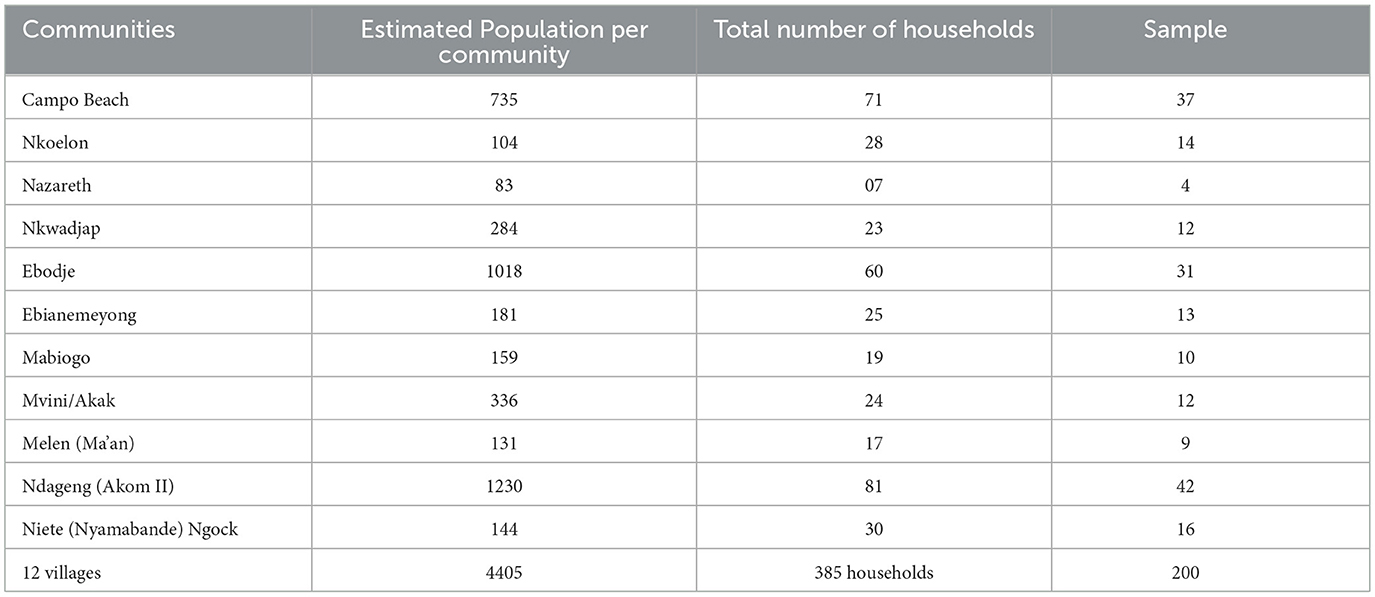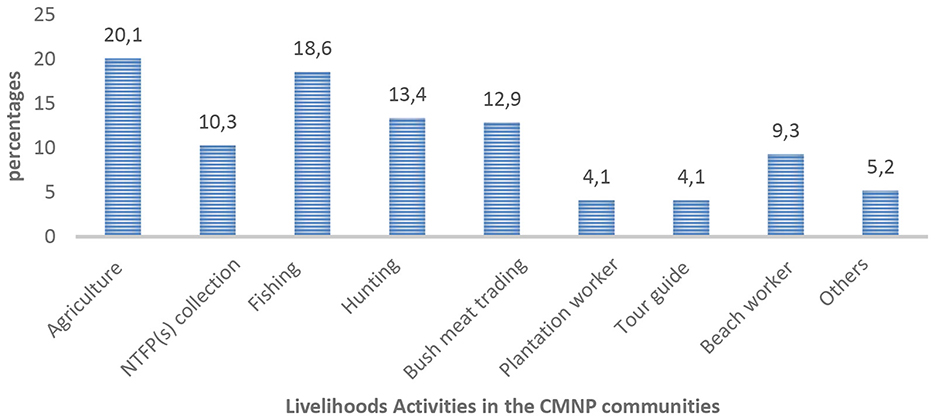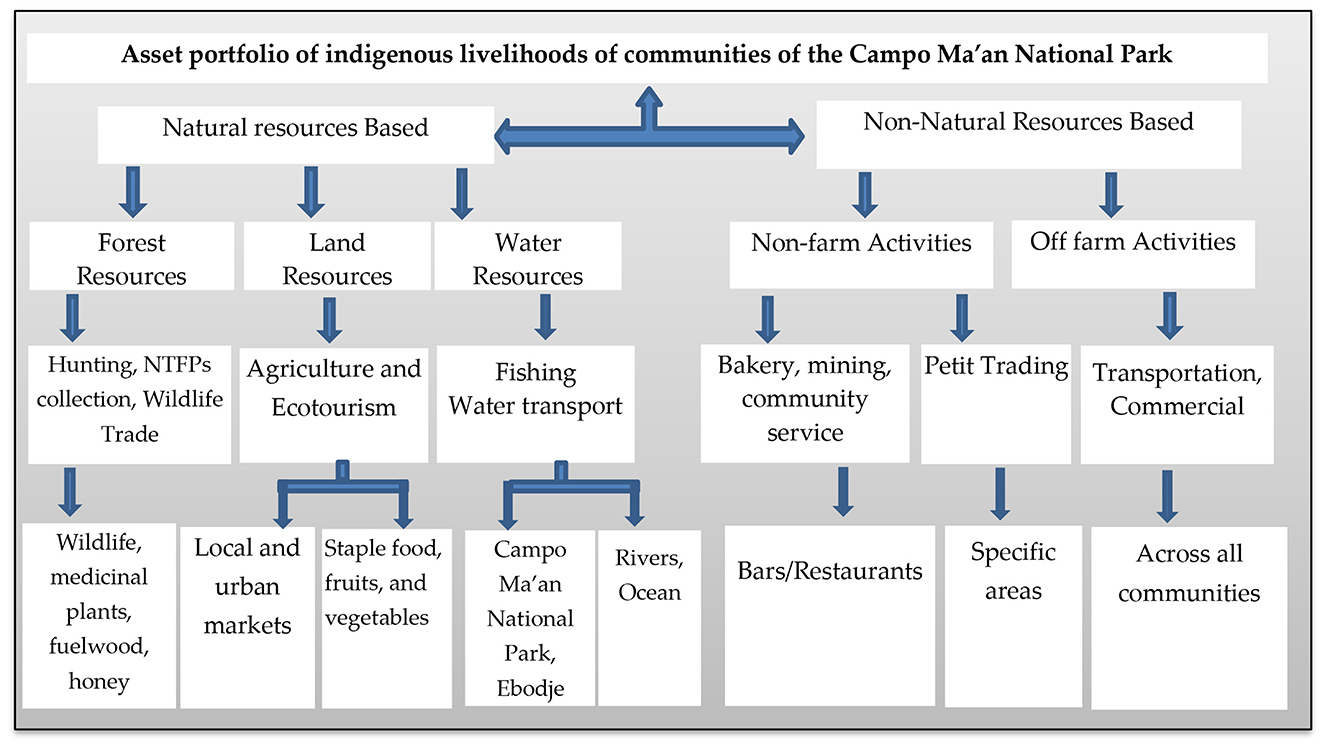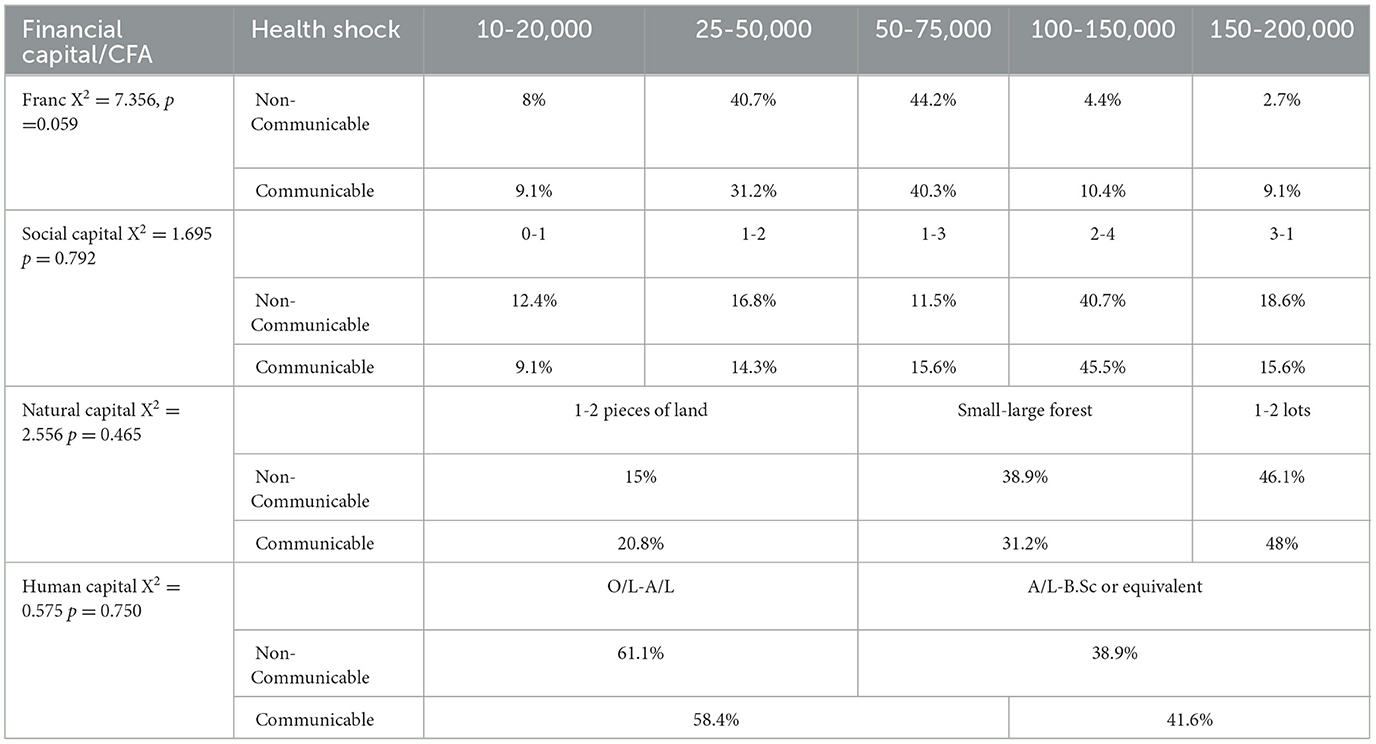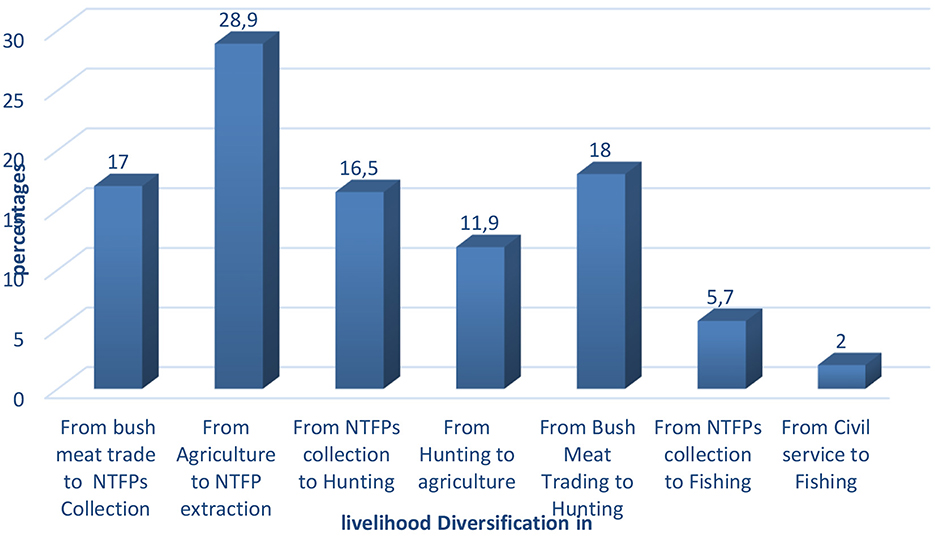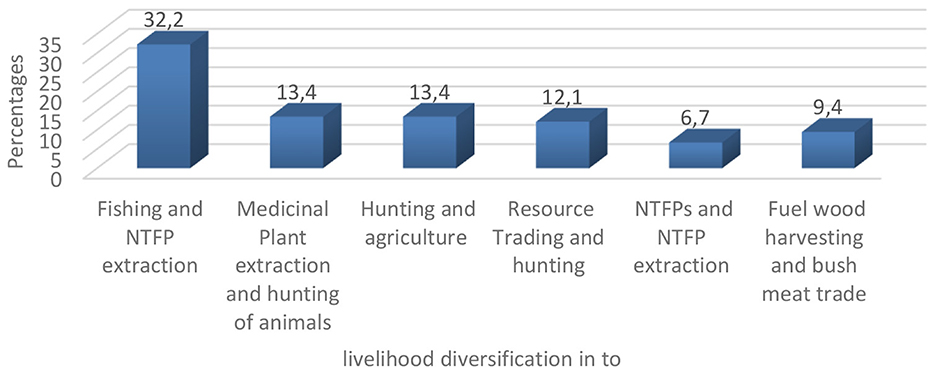- 1Forest Institutions and International Development (FIID) Research Group, Faculty of Environmental Sciences, Technische Universität Dresden, Dresden, Germany
- 2Department of Geography and Planning, University of Bamenda, Northwest Region, Bambili, Cameroon
- 3Department of Geography, University of Douala, Douala, Cameroon
- 4Department of Geography, HTTC, University of Bamenda, Bambili, Cameroon
The sheer impacts of communicable and non-communicable health shocks globally are increasingly visible on social, economic, and natural systems, with growing concerns, especially in sub-Saharan Africa. Despite this salience, micro-scale evidence on how health shocks induce shifts in resource-based livelihoods is lacking. This is particularly intense in the Campo Ma'an National Park communities. Thus, this study examines the extent to which livelihood systems have been reshaped by health shocks, including communicable and non-communicable diseases, in the Campo Ma'an National Park communities, particularly over the past 5 years. To achieve this aim, 200 natural resources dependent households were randomly sampled around the Campo Ma'an National Park, complemented by expert interviews (N = 6), Key Informant Interviews (N = 6) and Focus Group Discussions (N = 4). Data were analyzed descriptively using percentages, frequencies, and charts and inferentially using the Chi-Square Test. The results reveal significant differences in financial capital compared to all other capitals (X2 = 7.356, p =0.059), which is significantly higher for the contribution of communicable diseases compared to non-communicable diseases. Additionally, no significant difference was observed in the accumulation of social, natural and human capital comparing the results due to Communicable and Non-Communicable Health Shocks (p > 0.1). Health shocks are construed as unpredictable/unexpected changes or occurrences in human health, involving communicable diseases such as Malaria, STIs (HIV and AIDS), Tuberculosis, COVID-19, neglected tropical diseases and/or non-communicable diseases like Cardiovascular diseases, Hypertension, Cancer, Diabetes, Mental health ailments, amongst others. livelihood entails the stores, resources, claims, and access (assets, capabilities, and activities) required to sustain a living. The chi-square test indicates that communicable diseases contributed more to changes in livelihood capitals, especially financial capital, than non-communicable diseases, disrupting the normal functioning of individuals, households and communities, with severe impacts visible on human wellbeing as well as livelihood systems. Shifts in livelihood systems were further triggered by actor dynamics as conflicting interests and power distribution among local communities, government agencies, the private sector and NGOs, influenced livelihood strategies in terms of livelihood diversification, intensification and/or business-as-usual scenario. This informs the vulnerable dimension of the Sustainable Livelihoods Framework.
1 Introduction
Rising health challenges and uncertainties are becoming a mainstay globally with significant implications on human wellbeing and livelihood sustainability (Kuuwill et al., 2022; Kometa et al., 2025a,b; NCD Alliance, 2025; Rasolofoson, 2024; Piquer-Rodríguez et al., 2022; Attah, 2022), validating the link between human health and livelihoods (World health statistics, 2023). Experts' reports reveal that livelihood systems and strategies, especially in rural settings, are reshaped by shocks (Natarajan et al., 2022). For example, the sustainable livelihood framework provides a useful guide on the shifts in livelihoods assets, and strategies like diversification and intensification especially in resources dependent communities with high vulnerability to shocks (DFID, 2000), with some of the identified shocks including economic, political, social, cultural and natural (DFID, 2000; Hamada, 2024; Kimengsi and Mairomi, 2021). As a result, studies on dynamic livelihood assets and strategies in natural resources settings are essential as rising risks and impacts of health shocks (communicable and non-communicable diseases) are imminent (Duguma et al., 2021). This is underpinned by a lack of adequate preparedness for such unforeseen events affecting livelihood systems, especially in sub-Saharan African countries (Duguma et al., 2021).
The Global North, with the highest share of Non-Communicable Diseases, averages 89.6%, with resurging communicable diseases affecting progress on health coverage (World health statistics, 2023; Damon and Royer, 2013). Although not new, over the past century, health shocks triggered changes in social capital in Britain, influencing changes in Britain's schooling laws with severe impacts on educational attainment and wages. The recovery strategy targeted health policy efforts (Damon and Royer, 2013). Also, within the same period, Norway, Finland, Britain and the United States experienced cardiovascular diseases, linked with poor housing standards and diets, increasing the risk of ischaemic heart disease, especially among households with limited income and unemployment (Mazumder et al., 2010; Lleras-Muney, 2005). Recently, the COVID-19 pandemic was ranked the top trigger of death from communicable diseases affecting mental health and life satisfaction (Slater, 2024). In Europe, disruptions through health shocks led to shifts in financial and social capital in terms of labor supply and increased financial needs (increased medical costs) (Zhao et al., 2021; Gupta et al., 2015; Cohen et al., 2010). In the USA, studies indicate that early exposure to health shocks in Utero led to the 1918 influenza pandemic, due to limited socio-economic and healthcare outcomes, affecting social capital, especially low education and income levels, though with zero mortality recorded with impacts on livelihood systems (Sydenstricker, 1918; Fletcher, 2019; Gupta et al., 2015). Health shocks in Denmark affected labor force participation, especially among the elderly, with shifts in financial capital, especially among cancer patients (Gupta et al., 2015). These dynamics constitute the conceptual foundation of the Sustainable Livelihood Framework (Natarajan et al., 2022).
Scholarships in the Global South reveal high dependence on natural capital (trees, land) during health shocks, with concerns on access and benefits, particularly in rural settings (FAO and Report, 2022; Kometa et al., 2025a; Rasolofoson, 2024; Nguyen et al., 2022; Kuuwill et al., 2022). Shifts in livelihood capitals tend to influence livelihood strategies like diversification, as evident in countries like Nigeria, Ghana, Cameroon, Uganda, Tanzania, Cambodia, Laos, Thailand, Vietnam and Sri Lanka (Samson et al., 2024; Kometa et al., 2025a; Kuuwill et al., 2022; Nguyen et al., 2022; Kimengsi et al., 2019; Debela et al., 2012; Illukpitiya and Yanagida, 2008). However, the extent to which livelihood systems in natural resources communities were reshaped by communicable and non-communicable health shocks remains incomprehensible in SSA. For instance, in Nigeria, key factors influencing diversification included socio-economic factors like farm and off-farm sources. Particularly in states like Oyo and Osun, diversification was influenced by individual capabilities/ability, assets and gender, which are constrained by rural infrastructural problems, credit accessibility difficulties, marketing facilities, and technological challenges (Samson et al., 2024; Obi-Egbedi et al., 2016). Furthermore, studies in the rural landscapes of Tanzania, Rwanda, Uganda and Ghana reveal that diversification is triggered by geographic factors such as forests, grasslands and shrubland, as well as demographic factors like population density and household characteristics (Cooper et al., 2018; Debela et al., 2012). In South Asia, diversification is linked more with non-farm activities such as forests, which contribute up to 60% of rural household income to sustain livelihoods, though with disparities in land ownership in rural areas, particularly in Sri Lanka (Illukpitiya and Yanagida, 2008).
In the sub-Saharan region, more than half of the population relies on natural capital, particularly forests, land, water and woodland, with direct and indirect impacts on livelihoods (Ellis, 1999; UNEP, 2024; Amawa et al., 2020; Nkembi et al., 2022). However, translating these resources into sustainable livelihoods for the population remains a significant challenge, with huge implications at a wide scale (Natural resources Governance Institute, 2025). Although endowed with vital resources, the sub-region, alongside the entire African Region, bears 20% of the global burden from the impacts of Communicable and Non-Communicable Diseases (Niohuru, 2023), with severe implications on livelihood systems. For example, in 2019, non-communicable diseases were responsible for 37% of deaths in the SSA, with an increase of 24% in the year 2000 (Niohuru, 2023). WHO estimates reveal an increase in NCDs to 3.8 million by 2030, equivalent to 51% of premature deaths in the sub-region (NCD Alliance, 2025). The impact of health shocks on mortality remains within households, primarily reflected through shifts in livelihood capitals- financial, physical, natural, social, and human (Rasolofoson, 2024). This is the worst-case scenario when the deceased was a wage earner, as mortality triggers changes in household capital, especially natural and financial capital, and adult death increases reliance on resources such as gardens and fields (Hunter et al., 2007), producing negative livelihood outcomes.
Evidence of livelihood shifts induced by health shocks has been documented in West Africa, particularly in Ghana; however, there is a significant gap in the literature for Central Africa, especially in Cameroon. Diseases like malaria, tuberculosis and HIV and AIDS account for 23.66% of the national burden of diseases in Cameroon (Ministry of Public Health (MOH), 2016), with combined implications on mortality and morbidity with non-communicable diseases. Healthcare delivery in Cameroon, up to the introduction of Universal Healthcare Coverage in 2023, had been minimal. According to the National Health Accounts, out-of-pocket expenses account for 70% of the population, representing a significant impediment to many Cameroonians accessing healthcare (Ministry of Public Health, 2023). The socio-economic implications of communicable and non-communicable diseases increase mortality, economic stagnation, poverty and hunger in the country (Kometa et al., 2025a,b). However, despite this problem, micro-scale evidence of how health shocks induce shifts in livelihood systems is lacking in Cameroon (Kometa et al., 2025a). It remains incomprehensible how health shocks such as Communicable and non-communicable diseases impacted livelihood assets (human, social, natural, and financial capitals), household income and the coping strategies adopted by households and communities. Specifically, the role of health shocks in shaping livelihood trajectories or pathways in terms of livelihood diversification, or whether communities decided to intensify resource harvesting further, or whether it was a business-as-usual scenario in natural resources-dependent communities of the Campo Ma'an National Park affected by diseases, remains unclear. Therefore, the study sought to (i) identify dynamics in livelihood assets during shocks in the Campo Ma'an National Park communities, (ii) examine the dynamics in livelihood strategy during health shocks (communicable and non-communicable diseases) adopted by natural resources dependent communities of the Campo Ma'an National Park. With rising health shocks and growing concern for human health and livelihood sustainability, there is an urgent need to adopt and enhance sustainable livelihoods and countermeasures to cope with future shocks, presumed to be imminent, more dangerous or worse than past ones. This study is the first of its kind, as it contributes to this regard. Cameroon aims to achieve Universal Health Coverage by 2035, for a prosperous nation and enhance the African Development Agenda 2063, with human health and livelihood sustainability as essential components (Chenjoh et al., 2019). The study considers resource intensification to mean a scenario where resource users tend to engage more in a livelihood activity that was practiced before health shocks.
2 Conceptual framework
The study adapts the sustainable livelihoods framework based on a series of conceptual foundations including livelihoods, Sustainability, Vulnerability context, Livelihood Assets, and Transforming Structures and Processes. “livelihoods comprises the capabilities, assets (stores, resources, claims and access) and activities required for a means of living: a living is sustainable which can cope with and recover from stress and shocks, maintain or enhance its capabilities and assets and provide sustainable livelihood opportunities for the next generation and which contributes net benefits to other livelihood at the local and global levels and in the short and long term” (Natarajan et al., 2022). Sustainability is emphasized in livelihoods, taking into consideration economic, social and environmental dimensions. The vulnerability context is recognized as livelihoods are pursued, including trends, shocks and seasonality. Moreover, different assets- human capital, social capital, natural capital, financial capital and physical capital are embedded, alongside transforming structures and processes such as the role of institutions, policies, and organizations in shaping livelihood outcomes. The study draws on the framework's conceptual foundation as its analytical core, providing a holistic and people-centered approach to understanding health shocks and shifts in livelihood systems, especially in rural landscapes like the Campo Ma'an National Park communities. Shocks tend to be influenced by actors and power dynamics as well as the role of transforming structures and processes at the local level through endogenous and exogenous institutions, public and private policies, norms, taboos, and customs, with diverse outcomes reflected in changes in household assets. Households, therefore, adopt different coping strategies to manage health shocks. These include livelihood diversification, intensification and/or business-as-usual scenario. The vulnerability context looks at health shocks (communicable and non-communicable diseases). Livelihood assets represent the needs, priorities and perspectives that households depend on for their livelihoods, like financial capital, social capital, natural capital, and human capital. These capitals are reflective of the communities and were examined before and during health shocks in the region. In terms of Financial capital, the study selected livestock and household income to focus more on the financial stability and well-being of households during shocks. Transforming structures and processes focuses on the impacts of structures and processes (endogenous and exogenous institutions) on the management of health shocks and livelihood sustainability. See Figure 1. Thus, the Sustainable Livelihood Framework provided a useful guide for analyzing the dynamics of livelihood assets and household income, the strategies adopted by households to manage health shocks, as well as the influence of institutions (endogenous and exogenous) on disease management and livelihood sustainability. This system provides opportunities for natural resources-dependent activities, such as the gathering and domestication of Non-Timber Forest Products, agriculture, medicinal plants extraction, and non-natural-based livelihoods like migration, transport and petty trading.

Figure 1. Conceptual framework for analyzing natural resources-based livelihoods during health shocks (communicable and non-communicable diseases in the Campo Ma'an National Park communities (Adapted from DFID, 2000; Ellis, 2000; Kuuwill et al., 2022).
3 Materials and methods
3.1 Study area
The Campo Ma‘an National Park is situated in the ocean division of the south region of Cameroon. Created in the year 2000 through decree No. 2000/004/PM of January 6, it serves as compensation for environmental damages of the Chad-Cameroon pipeline project (CMNP, 2014). It covers a surface area of 264,064 hectares and is part of the Technical Operation Unit (TOU) of the first category. Its location extends Latitudinally from 2°10′-2°2′ North of the equator and between longitudes 9°50′-10°4′ of the Greenwich meridian. The Park borders the Republic of Equatorial Guinea to the South and the Atlantic Ocean to the west. Moreover, despite its creation in the year 2000 through decree, its existence dates back to 1932 as the “Campo Fauna Reserve” (CMNP, 2014). Reports indicate that the Park surrounding is constituted of about 100 sedentary villages whose population is estimated at about 280,000 people (CMNP, 2014), involved in major activities like Hunting, NTFPs collection, Wildlife Trade, Agriculture and Ecotourism, Fishing, and Water transport. Prominent villages include Akak, Nkeolon, Campo Beach, Mvas, Kwadjap, Mabiogo, Ebodje, Ebianemeyong, Akom II, Niete, and Nazareth. These villages possess protected species of animals, whose trafficking has increased the risk of zoonoses over the past few decades. Figure 2 presents the location of the Campo Ma'an National Park in Cameroon.
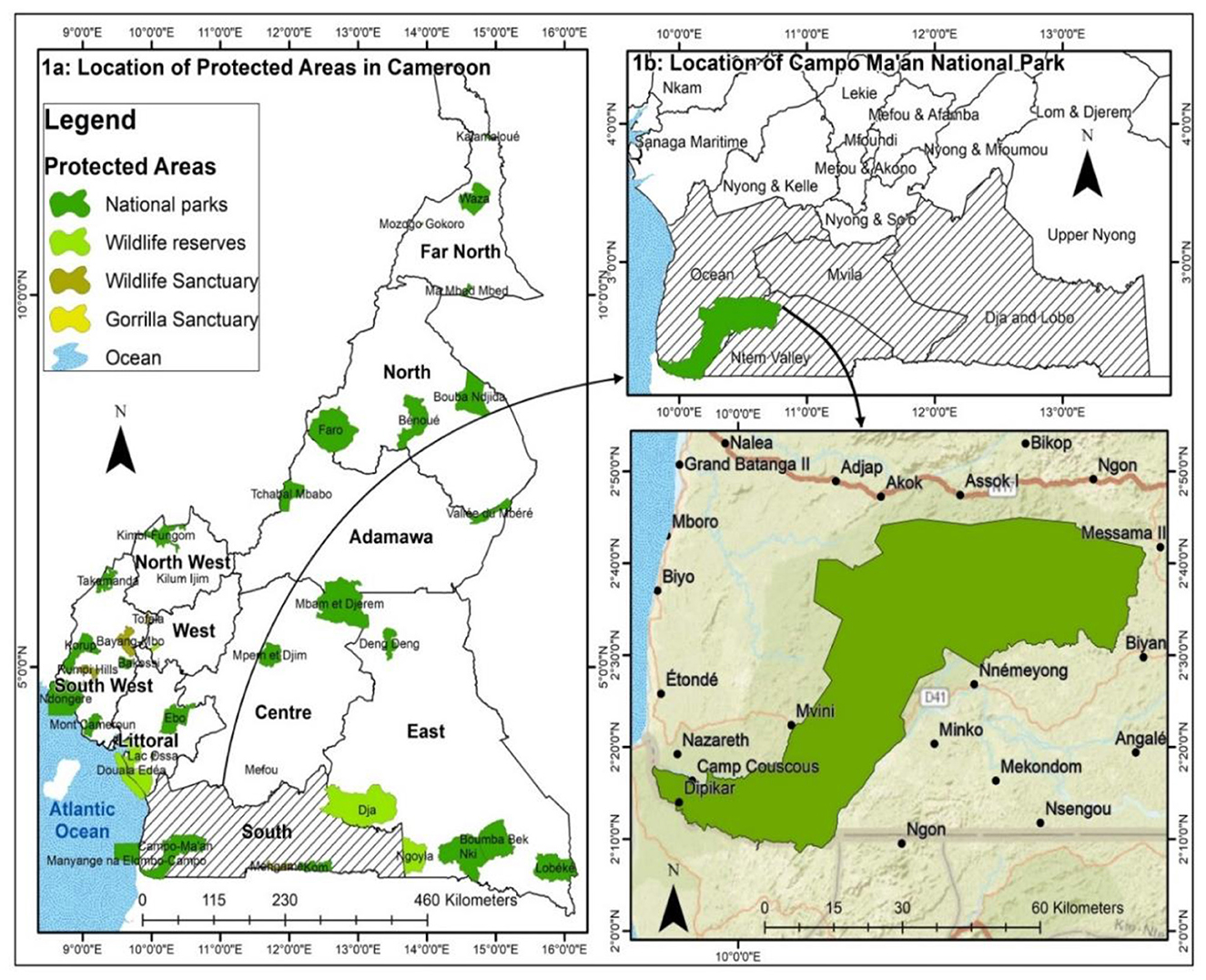
Figure 2. Location of Campo Ma'an National Park in Cameroon. Source: Administrative limits of Cameroon (NIC, 2020) and World Database on Protected Areas (UNEP-WCMC and IUCN, 2024).
3.2 Data collection
The study employed the Mixed-Methods research design to investigate the impacts of health shocks on livelihood systems and to examine the coping strategies adopted by households to manage health shocks in the resource-dependent communities of the Campo Ma'an National Park. Thus, 200 resource-dependent households were randomly sampled, with a 10% representativeness ensured in each community in the region. data collection instruments used included structured and semi-structured questionnaires, a Key Informant Guide, an Expert Interview Guide, and a Focus Group Discussion Guide, to collect quantitative and qualitative data on demographic characteristics, livelihood activities and health shock prevalence that were detailed, nuanced, and with increased validity and reliability. See Table 1. The instruments completed each other, capturing questions on shifts in livelihood strategies during health shocks as well as the categories and impacts of health shocks in the Campo Ma'an National Park communities. For instance, the interview guide comprised of questions on the implications of health shocks (communicable and non-communicable diseases) on natural resources-based livelihoods in the Campo Ma'an National Park communities. Also, the focus group discussion guide captured questions on the dynamics of livelihood capitals during health shocks in the Campo Ma'an National Park communities. These instruments were validated between October and November 2023 and translated into French. Two indigenes were recruited and trained in data instruments and procedures for 2 days based on indigenous knowledge and geography, to gain access to the communities and obtain first-hand information. Data collection was carried out between December 2023, January and August 2024. Key informant interviews (06) and expert interviews (06) were conducted, complemented by focus group discussions (04), made up of women, mixed group and youth group. This was based on a comprehensive list of communities that fit the research criteria obtained through reports of WWF Campo and AWF Campo. A 5 year recall period, beginning from 2019, was established for health shocks and shifts in livelihood systems in the Campo Ma'an National Park communities. Data was validated through data entry checks, cleaned and checked for inconsistencies. Ethical considerations were respected with informed consent obtained from all participants before data collection, and confidentiality was ensured through secure data storage.
3.3 Data treatment and analysis
The mixed-methods approach examined the impacts of communicable and non-communicable health shocks on livelihood capitals and coping strategies in the Campo Ma'an National Park communities. Using the Chi-square test, the analysis excluded missing values to ensure accuracy. Variables were recorded in alignment with the Sustainable Livelihood Framework by analyzing the relationship between communicable and non-communicable health shocks, livelihood capitals and coping strategies. Thus, the framework informed the coding scheme and variable selection (livelihood capitals, coping strategies during health shocks). The analysis focused on the impacts of communicable and non-communicable health shocks on each capital (financial, human, natural and social), and the coping strategies adopted during health shocks were examined. This applied descriptive and inferential statistics to analyse the relationship between health shocks and livelihood capitals, highlighting the importance of capitals in coping with communicable and non-communicable health shocks and the need for intervention in Sustainable Livelihoods. Data obtained through focus group discussions and informant and expert interviews were transcribed. The quantitative data were coded in SPSS (Statistical Package for Social Sciences) and transferred to Excel version 2021 to properly organize and structure data in a systematic way. This, to ensure easier analysis and interpretation within the context of the sustainable livelihood framework, with emphasis on the relationship between communicable and non-communicable health shocks and livelihood capitals and implications for sustainable livelihoods. The Chi-square distribution analyzed categorical data and determines the association between variables. Results have been compared for both communicable and non-communicable health shocks.
Where, for example,
a = the frequency of financial capital affected by health shocks
b = the frequency of social capital affected by health shocks
c = the frequency of natural capital affected by health shocks
d = the frequency of human capital affected by health shocks
N = the frequency of all observations.
4 Results
4.1 Resource-based livelihood activities in communities of the campo ma'an national park
The Campo Ma‘an landscape is endowed with forests, land and water resources, together with a wide range of livelihood activities able to sustain its present and future generations. Key livelihood activities include agriculture, hunting, fishing, NTFP collection, and forest conservation. Figure 3 illustrates key livelihood activities practiced in communities of the Campo Ma'an National Park.
Agriculture constitutes 20.1% of the population of the Campo Ma'an area. These include arable and livestock farming. This is followed by fishing with 18.6% in traditional or artisanal fishing, and industrial fishing is practiced. The least livelihood practiced is Plantation work and tour guiding, which constitutes 4.1%. Currently, despite the region's rich biodiversity, it suffers from livelihood insecurity, seasonality changes, and cultural and political factors. Current approaches aimed at improving resource livelihoods are inadequate in benefits and worsened by uncertainties, especially rising health shocks. Thus, livelihood diversification becomes primordial to cope. Communities employ diverse resource activities that serve as safety nets in an effort to enhance the wellbeing of the population. Figure 4 provides a visual representation of the asset portfolio of indigenous communities of the Campo Ma'an National Park in terms of their assets. Inhabitants of the region depend on natural resource-based and non-natural base activities producing different livelihood outcomes.
4.2 Health shocks and shifts in livelihood capitals in the campo ma'an national park communities
Households in the Campo Ma'an landscape are being affected by communicable and non-communicable health shocks, with severe implications for wellbeing and livelihood sustainability. These shocks are construed as unpredictable/unexpected changes or occurrences in human health, involving communicable diseases such as Malaria, STIs (HIV and AIDS), Tuberculosis, COVID-19, neglected tropical diseases and non-communicable diseases like Cardiovascular diseases, Hypertension, Cancer, Diabetes, Mental health ailments, amongst others. They are considered health shocks because they disrupt the normal functioning of individuals, households and communities, with severe impacts visible on human wellbeing as well as livelihood systems. The sustainable livelihood framework provides a useful guide for understanding shifts in livelihood systems brought about by communicable and non-communicable health shocks in the Campo Ma'an national park communities in terms of livelihood assets, livelihood sustainability and coping strategies. Transforming Structures and processes, like endogenous and exogenous institutions, contributed significantly to these shifts. Communicable diseases like malaria and COVID-19 increased labor incapacity, morbidity, healthcare expenses, income lost, and mortality, affecting social capital and coping mechanisms. Similarly, non-communicable diseases increased long-term health impacts, with potential income loss, reduced labor productivity, thus strengthening adjustments in livelihood strategies. Health shocks induced shifts in livelihood assets such as human, financial, social and natural capital, with repercussions for human wellbeing through increased vulnerability in the region. Inhabitants, therefore, adopted diverse livelihood strategies including livelihood diversification and intensification. However, for others, it was business as usual. Despite slight positive shifts in capitals, especially financial capital (see Figure 5), out-of-pocket expenses for medical treatment significantly altered the wellbeing of the resource-dependent communities, as well as the sustainability of the resources. Social groupings (social capital) played a vital role in coping with the impacts of health shocks, highlighting the need to enhance livelihood wellbeing through diversification, intensification, and healthcare access.
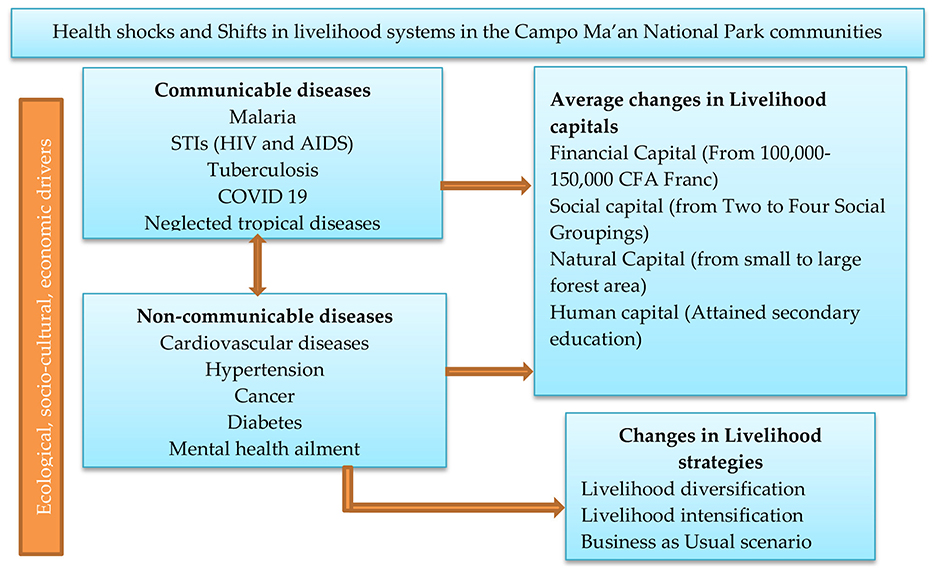
Figure 5. Health shocks and shifts in livelihood systems in the Campo Ma'an National Park communities.
The Chi-square test statistics reveal significant differences with respect to financial capital compared to all other capitals (X2 = 7.356, p =0.059), with a major contribution in favor of communicable diseases compared to non-communicable diseases. For instance, the proportion of respondents in Campo Ma'an communities who have witnessed financial increase from 100,000 CFA Francs to 150,000 CFA Francs was significantly higher due to Communicable Health Shocks (malaria, HIV and AIDS, Tuberculosis, and COVID-19) as compared to non-communicable Health Shocks (hypertension, cardiovascular diseases, cancer, obesity) (10.4% and 4.4% respectively, X2 = 7.356, p =0.059). Similarly, the proportion of respondents in Campo Ma'an who have witnessed an increase from 150,000 CFA Francs to 200,000 CFA Francs was significantly higher due to Communicable Health Shocks as compared to non-communicable Health Shocks (9.1%% and 2.7% respectively, X2 = 7.356, p =0.059). On the other hand, no significant difference was observed in the accumulation of social, natural and human capital compared to the results due to Non-Communicable and Communicable Health Shocks (p > 0.1) (Table 2).
Empirical evidence revealed that before the advent of health shocks, 80.1% of the population attested having earned between 10,000-50,000 CFA Francs per month, while 13.9% indicated having earned between 100,000 - 150,000 CFA Francs. As a result of Health shocks, households experienced shifts in their financial capital. For instance, 40.1% expressed a shift between 10,000 - 50,000 CFA Franc. Additionally, 39.8% of the population expressed an increase from 50,000 CFA Franc to 75,000 CFA Franc, while 7.9% expressed a change from 100,000 CFA Franc to 200,000 CFA Franc. However, not all inhabitants experienced a positive change; some experienced a negative change in their financial capital. For instance, 10% expressed a change between 100,000 - 25,000 CFA Francs per month over the last 5 years. The social capital of the Campo Ma'an National Park communities entails social resources upon which the indigenous people draw to pursue their livelihood objectives, like membership in groups. Before the advent of health shocks, 28.4% of the population belonged to one social group, while 41.8% belonged to two social groups. However, 12.8% of the population belonged to no social group, while 17% belonged to three social groups. However, after health shocks, 15.5% of the population confirmed a shift from one social group to two social groups. Also, 41.8% of the population moved from two social groupings to four social groups. Additionally, 10.8% of the population moved from no social group to one social group. Furthermore, 12.9% of the population moved from one social group to three in the region. However, despite the positive change in social capital experienced, others experienced a negative change, as indicated by 17% of the population moving from three social groups to only one. The natural capital was expressed in terms of the number and size of lands, forests or water areas managed. Before the advent of health shocks, 44% of the population involved in fishing activities managed one fishing lot, especially on the Atlantic coast, and in local rivers that flow across the landscape. Moreover, 18% of the population involved in agriculture owned one farmland with farm sizes ranging between 2 hectares and 5 hectares. Furthermore, 38% of the population involved in forest exploitation managed only a small forest area of less than 0.1 km2. After health shocks, 39% of the population reported an increase in farmlands from 1 to 2 hectares. Also, 27% attest that farmlands have increased from 1 to 3 hectares. Furthermore, 20% of the population reported an increase in farmlands from 2 to 4 hectares, while 9% confirmed that some farmers now manage 5 hectares or more in the region. However, only 5% of the population manages about a hectare of farmland in the communities surrounding the Campo Ma'an National Park. Human capital accumulation in the communities of the Campo Ma'an National Park is generally low. This is expressed in terms of the skills, knowledge, and ability of labor to perform tasks efficiently. Before health shocks, more than 55% of the population around the Park had obtained no education, while an average of 33% of the population had obtained primary education. Moreover, 7.2% of the population obtained the GCE advanced level or equivalent. However, the post-health shocks period witnessed changes in human capital accumulation in the region. For instance, 33.8% of the region's population attained secondary education, while 22% attained primary education. 7.2% of the population had a BSc or equivalent. Moreover, 15% of the population attained vocational training, especially in Niete, while 22% had no education.
4.3 Health shocks and livelihood strategies in the campo ma'an national park communities
Several livelihood activities sustain the population of the Campo Ma'an National Park communities, including natural Resource-based and Non-resource-based (see Figure 4). Health shocks led to shifts in livelihood systems, particularly livelihood strategies, including livelihood diversification, aligning with the Sustainable Livelihood Framework, as it influenced livelihood environmental dynamics with pathways to making a livelihood. households could cope with the impacts of health shocks through livelihood diversification. This study considers diversification to mean an incidence whereby resource users engage in a new resource-based activity for subsistence, commercial or both. Over the past 5 years, communicable and non-communicable diseases have triggered households to diversify their livelihood activities. Communicable diseases like COVID-19 exacerbated the existence of health issues by creating a conducive atmosphere for the spread of infectious diseases. Cases of malaria increased, disrupting TB treatment services alongside hypertension and diabetes. These dynamics led to shifts, as several households diversified in, and others diversified into, the former denote a shift within the same livelihood activity, while the latter denotes a complete shift from one livelihood activity to another. For instance, in the case of diversification in, several natural resource-dependent communities diversified from hunting bush meat to hunting chimpanzees, while others diversified from hunting chimpanzees to hunting gorillas. Also, some individuals diversified from hunting antelope to hunting both chimpanzees and gorillas. These changes were triggered by economic factors influenced by health shocks, as health shocks led to changes in market demands targeting different species. in addition, diversification into, denotes a shift from, for example, crop cultivation to the hunting of animals, while others diversified from fishing to the exploitation of NTFPs. Finally, others diversified from agriculture to forest exploitation. Figure 6 presents livelihood diversification over the past five years due to health shocks.
A significant proportion of the population of the Campo Ma'an landscape experienced natural resource diversification into. That is, they incorporated other livelihood activities into already existing ones during health shocks. For instance, by engaging in agriculture and forest exploitation, others incorporate fishing and NTFP extraction. Others also incorporated hunting and medicinal plant extraction, while others were involved in NTFPs and tour guiding. Others incorporated the harvesting of fuel wood and bush meat trade. These strategies ensure the sustainability of livelihoods through politics of influence and access, aligning with the Sustainable Livelihood Framework. Figure 7 presents livelihood diversification into, over the past 5 years due to health shocks.
With the emergence and re-emergence of communicable and non-communicable diseases in the region, some communities diversified their livelihood activities further, while others intensified their livelihood strategies further, while for some people, it was Business-as-usual. These strategies, based on the influence of institutions (structures and processes) especially at the local level, contributed to sustaining the population from the impacts of health shocks, thus aligning with the Sustainable Livelihood Framework. Figure 8 presents the scenario of livelihood strategy before and after health shocks in the region, comprising resource diversification, resource intensification and business as usual.

Figure 8. Shifts in livelihood strategies (diversification, intensification, business-as-usual) before and after shocks in the Campo Ma'an National Park communities.
The extent to which communities and individuals affected by health shocks depended on natural resource-based or non-natural base activities was a function of the severity of communicable and/or non-communicable diseases, the role played by transforming structures and processes (endogenous and exogenous), resource accessibility, socio-demographic, cultural and economic characteristics like household size, gender, age, and capital. Figure 9 presents the spatial distribution of livelihood diversification activities.
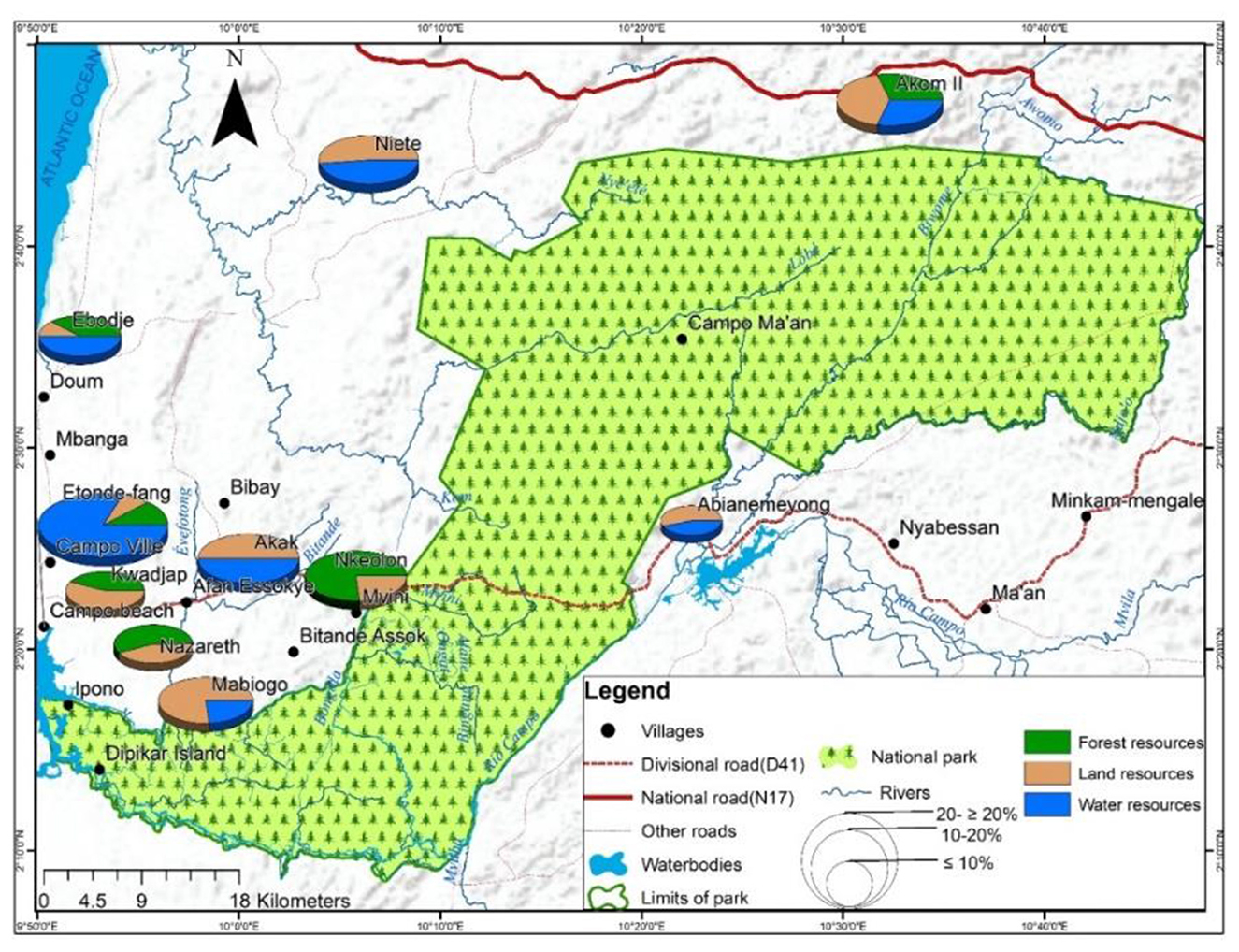
Figure 9. Variations in livelihood diversification in land, forests, and water resources in and around the CMNP.
Forest resources were more diversified in villages like Nkeolon with 23%, followed by Niete with 12% and lastly by Campo Beach with 5%. Land resources were more diversified in Mabiogo with 20%, followed by Akak and Niete with 15% respectively. Ebodje experienced the least land diversification in the region. Furthermore, water resources were more diversified in Campo Beach with 40%, followed by Ebodje and Mabiogo.
In terms of livelihood intensification, some households decided to engage further in livelihood activities before health shocks. The extent of resource intensification in the region was a function of household characteristics and capital owned and managed by the population of the Campo Ma'an National Park. Figure 10 presents the extent of livelihood intensification in the landscape over the last 5 years.
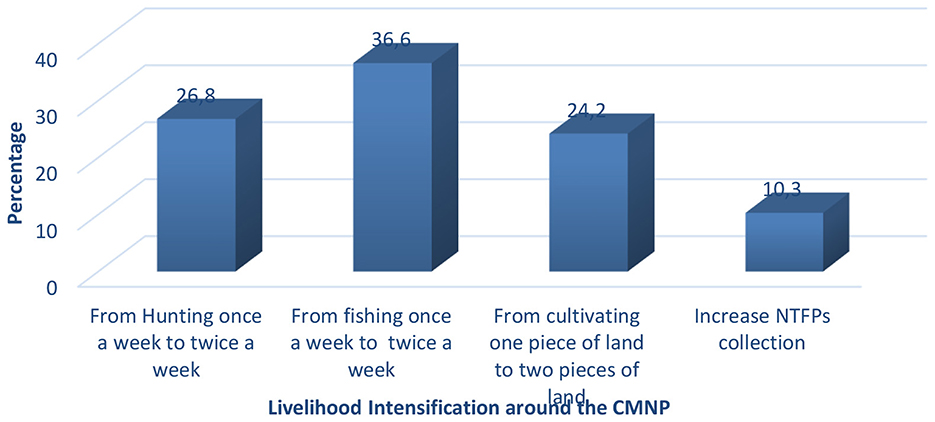
Figure 10. Livelihood intensification in and around the Campo National Park over the past five years (2019- 2023).
Several communities intensified their livelihood activities. For instance, in the domain of forests as a natural resource, 26.8% of the population went from hunting once a week to hunting twice a week. In the domain of fishing, 36.6% of the population said fishing intensified from once a week to twice a week. In the domain of land as a natural resource, 24.2% of the population intensified it from cultivating one piece of land to cultivating two pieces of land, especially over the past 5 years, while 10.3% of the population intensified in medicinal plant extraction. In terms of forest resources, there was more intensification in Nkeolon village with 17%, followed by Niete with 15%. Villages such as Akak witnessed resource intensification. However, Campo Beach witnessed less forest intensification, being a typical fishing village. Also, in the domain of land resources intensification, Mabiogo, Niete, and Akak, witnessed more intensification with 15% respectively, followed by Nkeolon, Nkwadjap and Akom II. Furthermore, water resources intensification was more at Campo Beach with 40%, followed by Ebodje. Ebianemeyong and some parts of Niete. See Figure 11.
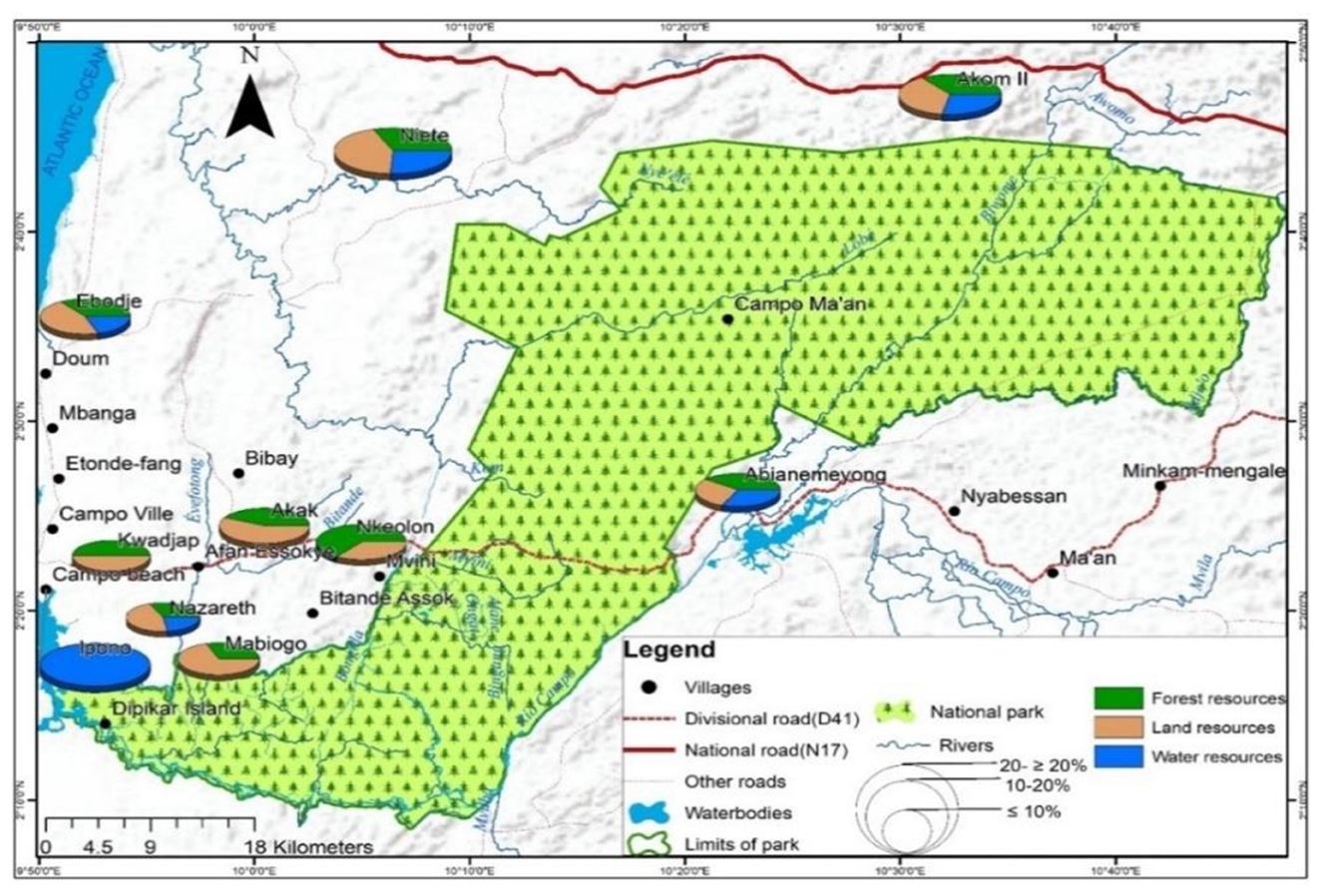
Figure 11. Variations in livelihood intensification in land, forests, and water resources around the Campo Ma'an National Park. Source: Geo-database of Cameroon (2022) and Field studies (2024).
5 Discussion
Over the past 5 years, 90% of the population of the Campo Ma'an National Park perceived changes in their livelihood assets, including, especially, financial capital, alongside social, natural, and human capital. Communicable health shocks, such as malaria, COVID-19, HIV/AIDS, Neglected Tropical Diseases, particularly Human African Trypanosomiasis (HAT), contributed more to shifts in livelihood capitals than non-communicable health shocks like cancer, hypertension, diabetes, and cardiovascular diseases. The impacts produced diverse livelihood outcomes, as some individuals and communities experienced positive shifts, while others experienced negative shifts in livelihood capitals. In terms of financial capital, 10% of the population experienced a negative shift from 100,000CFA Franc to 25000CFA franc per month over the past 5 years, while a signinificant proportion of the population attests that health shocks led to positive shifts in financial capital, with 40.1% earning between 10,000- 50,000 CFA Franc, 39.8% earning between 50,000 CFA Franc to 75,000 CFA Franc, and 7.9% earning between 100,000- 200,000 CFA Franc per month. Shifts in financial capital were reflected in human capital (educational attainment), social capital (social groupings), and natural capital (forestland and water resources managed). The results are counterintuitive, as shifts in livelihood assets triggered by health shocks increase healthcare expenses, loss of income, and productivity, minimizing ecotourism benefits, coupled with economic instability in the Campo Ma'an National Park communities. On a positive note, there is an increased demand for healthcare services, an increase in employment in healthcare-related research, humanitarian aid and funding, along with new economic opportunities. The findings align with the situation in rural West Sumatra, as a communicable disease like the COVID-19 pandemic led to widening inequalities in livelihood capitals, with poor households experiencing significantly low income, less access to agricultural inputs and strict barriers to distance learning for children; meanwhile, less struggling households expanded cultivation (Mahdi et al., 2025). Moreover, in the Kwahu South District of Ghana, the COVID-19 Pandemic led to a decline in financial assets, with a lesser change in social assets, influenced by socio-economic factors, especially migration, with severe impacts on women. Households witnessed income loss and less savings due to restrictions on market access (Kuuwill and Kimengsi, 2024). Additionally, the situation was more severe in China as the COVID-19 pandemic affected financial capital, leading to a decline in household income per capita of $131, which is 6.0% of each household's annual income per capita. Additionally, households incurred a loss of family assets per capita of $2130, which is 9.7% of household assets per capita. The spillover effect of these financial constraints affected mental health and health behavior as households incurred private costs of $5,463 on average over the past 5 years, and a social financial burden of $948 in 5 years in reimbursement and medical and social welfare transfers. At the national level in China over the past 5 years, the financial burden of health shocks amounted to $172.1 billion (Wang et al., 2023). Moreover, a similar scenario was observed in Cambodia, where health shocks reduced household per capita income, affecting the livelihoods of rural people, increasing the risk of poverty (Nguyen et al., 2022). Similarly, in the Congo Basin, Natural resource-dependent peoples and local communities were affected by the impacts of health shocks (Kometa et al., 2025b). The government's responses to social needs were primarily in urban areas while neglecting rural communities (Attah, 2022). However, the findings contradict the situation in Bangladesh, as the interference of development partners in project implementations led to positive shifts in livelihood capitals, especially in the Khutamara Union (Hossain M et al., 2024). In contrast, in East Africa, health shocks promoted the informal sector as the Batwa in Uganda and the Masai in Kenya were heavily involved in handicrafts, livestock rearing, and tourism. In some areas, health shocks and restrictions led to severe economic downturns. In the forest sector, many indigenous communities retreated deeper into the forests for fuelwood, food, and shelter, as well as the utilization of medicinal plants for protection against COVID-19 infection. A similar situation was reported in West Africa, leading to the overexploitation of forest resources. Additionally, the high cost of transportation hampered transportation to markets (Attah, 2022). These findings underscore the need for interventions that strengthen livelihood capitals through institutional congruence in resource-dependent regions, enabling communities and individuals to cope with emergent shocks and ensure future livelihood sustainability and improved wellbeing.
These dynamics align with the SLF as communicable and non-communicable health shocks (vulnerability context), leading to shifts in livelihood assets, particularly financial capital in the Campo Ma'an landscape. endogenous and exogenous institutions represent the “political economy”, in which livelihoods are embedded, reproducing shifts in welfare systems in the region. These livelihood outcomes indicate significant losses and income loss in the resource communities. Moreover, conflicting interests, incentives, traditional beliefs such as the “Jengi” (Personal harm and disconnection from tribe), “Embouambou” (Ill health or death) “Yeli” (Ill health due to wildlife attack during the big hunt), further let to dynamics in livelihoods inducing health shocks and negative shifts in livelihood capitals with repercussions on human wellbeing and livelihood sustainability. Diverse livelihood strategies were thus employed as coping mechanisms in response to the impacts of health shocks, ranging from livelihood diversification, intensification and/or business-as-usual scenario. That is, some communities decided to diversify resource harvesting further, while others intensified resource harvesting further, and for some, it was a business-as-usual scenario. Generally, the livelihood systems of the Campo Ma'an National Park communities were distorted, altered and modified due to the severity of communicable and non-communicable diseases over the past 5 years. Institutional interplay involving multiple actors such as local communities, government agencies, the private sector and NGOs further enhanced the dynamics through enforcement mechanisms involving structures and processes with negative implications in conservation. Constant and continuous deforestation for projects and wildlife damage to crops affect conservation efforts, triggering shocks and shifts in assets. The study contributes to the asset pentagon by establishing the asset portfolio of the inhabitants of the Campo Ma'an National Park. These include resource-based livelihoods related to forests, lands and waters and non-resource-based livelihoods in the region, including on-farm and off-farm livelihood activities. Additionally, the study edifies the SLF by establishing that livelihood strategies employed during health shocks in the Campo Ma'an National Park communities involved livelihood diversification, intensification and business-as-usual scenario.
The least affected capital was physical capital. Changes in physical capital over the past 5 years have been minimal in the Campo Ma'an National Park communities. The quality of water supply and proper sanitation in communities of the Campo Ma'an National Park continue to pose serious problems, affecting a significant proportion of the region's population, coupled with challenges accessing information and communication, especially in the Ma'an area. This triggers health shocks. On average, inhabitants travel 50-75km to access health care and urban services. These inadequacies in infrastructural development contribute to underdevelopment and affect human wellbeing. In contrast, for example, in the United States of America, the effects of the COVID-19 pandemic led to the implementation of lockdown measures with significant implications on physical capital, especially infrastructural demand. Thus, communicable and non-communicable diseases led to some changes in the demand for physical capital, like infrastructure, across 2020. Access to education, sanitation, washing, and professional services was affected. The implementation of lockdown measures contributed to the transformation of infrastructural services and shifts in employment to remote areas. Education was hampered alongside commercial activities (McArthur et al., 2021). The Chi-square test statistic revealed significant differences in financial capital as compared to all other capitals. This is significantly higher for the contribution of Communicable diseases as compared to non-communicable diseases with impacts on livelihood systems, thus supporting the SLF with emphasis on the importance of livelihood capitals
Communities depend on streams and brooks meandering through different villages in the landscape. Thus, the opportunity cost associated with very minimal infrastructure in the region precludes health, wealth generation initiatives and health services. The distance factor and non-congruence between endogenous and exogenous institutions restrict mobility and conservation initiatives. This limits low-income earners and resource users from accessing resource benefits. Access to information and communication is limited, especially in the northwest section of the park communities, restricting communication and connectivity with the rest of the world. Also, 20.1% of the population reports difficulties in accessing different communities around the Campo Ma‘an National Park. This is particularly visible in the Ma'an area, where motorable roads have been reduced to footpaths, making mobility in the region very difficult and transport costs unaffordable for the rural poor.
5.1 Livelihood diversification around the campo ma'an national park
The emergence and re-emergence of health shocks (communicable and Non-Communicable diseases) had varying effects on livelihood systems as communities survived through different livelihood strategies and actor constellations with diverse livelihood outcomes. The results demonstrate that health shocks triggered shifts in livelihood assets, particularly financial capital and household incomes, shaping livelihood trajectories or pathways for individuals and communities affected by health shocks. Thus, some households decided to diversify their resource harvesting further, while others decided to intensify resource harvesting further, and for some, it was a business-as-usual scenario. These pathways support the sustainable livelihood conceptual foundations as resource diversification in communities of the Campo Ma‘an National Park was triggered by changes in the asset pentagon as a result of health shocks and the influence of power dynamics among actors in resource communities. The extent to which these communities and individuals diversified their livelihood options was a function of actor dynamics, shaping demands for resources, socio-demographic and economic interplays. This had profound implications for conservation and natural resources. Socio-demographic characteristics and culture also form a major trigger involving household size, gender, age, and natural capital. Local activities to ensure better livelihoods for families and communities strive in the region, even though labor and manpower remain insufficient, exposing the region to health shocks through food insecurity and poverty. Diversification relates to an incidence whereby resource users engage in a new resource-based activity for subsistence, commercial or both. Households in the Campo Ma'an landscape diversified their resource harvesting over the past 5 years. while some practiced diversification in, others diversified into. Diversification in, denotes, for instance, from hunting chimpanzees to hunting bush meat (small rodents and mammals) or vice versa, while others diversified from hunting chimpanzees to hunting gorillas and antelopes. In addition, some diversified from hunting animals to crop cultivation, and others from fishing to NTFPs harvesting. And finally, others diversified from agriculture to forest exploitation. Diversification was triggered by changing demands for specific resources as a result of communicable and non-communicable diseases and conflicting power distribution between endogenous and exogenous institutions. Diversification was adopted as a household's survival strategy to improve human wellbeing, enabling them to cope with health shocks and reduce poverty in the landscape. These results were similar in other contexts. For instance, in the Bia West District of Ghana, Kuuwill et al. (2022) ascertain that health shocks led to diversification into forest-based activities more than intensification and the activities diversified into, including fuelwood collection, medicinal plants extraction, fruit gathering and beekeeping. However, others intensified. Increasing diversification had the potential to enhance human wellbeing but also had adverse implications in terms of resource sustainability. This is contrary to what was reported in Andhra Pradesh in India, where households adopted strategies to cope with health shocks such as savings, receiving help, credit or the sale of assets; some took more work and reduced expenditure (Sowmya, 2014). The situation is slightly different in the case of Bangladesh, where households bear the costs of healthcare through out-of-pocket payments to meet healthcare costs, as households sold their means of livelihoods, borrowing cash and marketing their livestock. These coping strategies affected their wellbeing and hindered attempts to achieve livelihood sustainability and human wellbeing enhancement, despite their engagement in poverty alleviation programs (Kabir et al., 2019). Moreover, land diversification in Thailand and labor diversification in Vietnam helped to improve per capita consumption when households faced covariate shocks (Nguyen et al., 2022). These findings emphasize the need for interventions that enhance livelihood diversification and resource sustainability for improved human wellbeing in the resource-dependent landscape.
5.2 Livelihood intensification in the campo ma'an national park communities
Several communities and households intensified their livelihood activities further in forest, land and water resources during health shocks. These resource-based livelihoods were reshaped in the Campo Ma‘an landscape because of health shocks, influenced by structures and processes (institutions and actors in natural resources management). This affected the wellbeing of the resource-dependent communities in terms of household incomes and assets. In fishing, for example, 36.6% of the population intensified from fishing once a week to fishing twice a week, and 24.2% of the population intensified from cultivating one piece of land to cultivating two pieces of land. Moreover, 10.3% of the population intensified further in medicinal plant extraction. These findings demonstrate that health shocks can lead to significant livelihood losses, especially in resource-dependent communities. Thus, the study highlights the important role of social capital (social groupings) in coping with the impacts of health shocks, which often require medical requirements borne through out-of-pocket expenses to improve wellbeing. However, ecotourism was the least intensified livelihood strategy in the landscape over the past 5 years, with repercussions on the populations in terms of benefits. The extent of resource intensification in the region was a function of actor constellation, market dynamics, assets, and household demography of the resource landscape. Farmers intensified their activities, with some expanding the size of their farms and others acquiring more farmland, striving to meet basic needs through the practice of agriculture. The impact of Health shocks in the Campo Ma'an landscape affected all age groups directly or indirectly, especially the elderly, 65 years and above, resource users, illiterates, disabled persons and persons with low or negative savings. The most affected faction was the elderly, 65 years and above, due to natural and biological inability to resist disease attacks, making them vulnerable to disease attacks, especially malaria, tuberculosis and COVID-19. The least affected were people with low and negative savings rates in the communities. These findings are consistent in different contexts; for example, in India, several efforts have been made to improve agricultural development with considerable success. However, health shocks, such as the COVID-19 pandemic, raised issues related to the potential of resource systems to enhance the wellbeing of the population and the sustainable livelihoods of agricultural systems during shocks (Preuße, 2023).
6 Conclusion
Over the past 5 years, the influence of health shocks–communicable and non-communicable diseases–led to shifts in livelihood assets, particularly financial capital in resource-dependent communities of the Campo Ma'an National Park. These shocks were influenced by power dynamics between actors, structural conditions, as well as transforming structures and processes, especially at the local level (“political economy”). Endogenous and exogenous institutions, private and public policies, norms, policy, taboos, and customs, produced outcomes mirrored through changes in household assets, especially financial capital, social, natural, physical and human capitals, thus aligning with the conceptual foundations of the Sustainable Livelihood Framework. Consequently, communicable diseases such as malaria, COVID-19, and HIV AIDS, as well as non-communicable diseases like cardiovascular diseases, cancer and diabetes, led to the adoption of different livelihood strategies as coping mechanisms involving livelihood diversification and intensification, both on-farm and off-farm portfolios. Generally, livelihood diversification in land and forest resources accounts for 50% of the population; meanwhile, livelihood intensification in water and fisheries accounts for 40% of the population, with a focus on recovering from health shocks and ensuring wellbeing. However, 10% of the population reported a business-as-usual scenario, especially over the past 5 years. Thus, shifts in livelihood systems among households were mixed, with some experiencing positive shifts, while others experienced negative shifts, and for some, it was a business-as-usual scenario. Power dynamics among actors in natural resources communities of the Campo Ma'an National Park further catalyze livelihood shifts, especially through conflicting interests and actor constellations (see Figure 1). The study enlightens the SLF by establishing livelihood strategies employed during health shocks, such as livelihood diversification, intensification and business-as-usual scenario. Additionally, the findings inform the vulnerable dimension of the sustainable livelihoods framework and contribute to the asset pentagon by establishing an asset portfolio on resource-based and non-resources based livelihoods, on-farm and off-farm livelihood activities in the Campo Ma'an landscape. Essentially, there is a need for more engaged policy intervention to develop sustainable livelihood systems, especially during health shocks. Moreover, a comparative study which covers different health risk regions and resource-based communities could provide complementary empirical evidence.
Data availability statement
The original contributions presented in the study are included in the article/supplementary material, further inquiries can be directed to the corresponding author.
Ethics statement
The studies involving humans were approved by Department of Geography and Planning scientific research committee. The studies were conducted in accordance with the local legislation and institutional requirements. The Ethics Committee/institutional review board waived the requirement of written informed consent for participation from the participants or the participants' legal guardians/next of kin because Cultural and social considerations. The manuscript presents research on animals that do not require ethical approval for their study. Written informed consent was obtained from the individual(s) for the publication of any potentially identifiable images or data included in this article.
Author contributions
RK: Conceptualization, Investigation, Methodology, Writing – original draft, Writing – review & editing. CW: Supervision, Validation, Writing – original draft, Writing – review & editing. NE: Data curation, Writing – review & editing, Writing – original draft, Validation, Visualization. JK: Data curation, Formal analysis, Supervision, Writing – original draft, Writing – review & editing, Methodology, Validation.
Funding
The author(s) declare that no financial support was received for the research and/or publication of this article.
Conflict of interest
The authors declare that the research was conducted in the absence of any commercial or financial relationships that could be construed as a potential conflict of interest.
The author(s) declared that they were an editorial board member of Frontiers, at the time of submission. This had no impact on the peer review process and the final decision.
Generative AI statement
The author(s) declare that no Gen AI was used in the creation of this manuscript.
Any alternative text (alt text) provided alongside figures in this article has been generated by Frontiers with the support of artificial intelligence and reasonable efforts have been made to ensure accuracy, including review by the authors wherever possible. If you identify any issues, please contact us.
Publisher's note
All claims expressed in this article are solely those of the authors and do not necessarily represent those of their affiliated organizations, or those of the publisher, the editors and the reviewers. Any product that may be evaluated in this article, or claim that may be made by its manufacturer, is not guaranteed or endorsed by the publisher.
References
Amawa, S. G., Atiekum, Z. E., Kimengsi, J. N., and Sunjo, T. E. (2020). Water resources exploitation practices and challenges: the case of river meme, Cameroon. J. Geogr. Environ. Earth Sci. Int. 24, 13-24. doi: 10.9734/jgeesi/2020/v24i630232
Attah (2022). Challenges, Strategies, Recovery Measures and Best Practice for Reducing Impact of COVID-19 on Forests and the Forest Sector, Africa Region Report. Second Assessment of the Impact of COVID-19 on Forests and Forest Sector in the African Region. Prepared for the 17th session of the United Nations Forum on Forests, 2022.
Chenjoh, J. N., Raymond, A., Saidu, Y., Cheng, N. I., Nzuobontane, D., Atemnkeng, J. T., et al. (2019). Reaching universal health coverage by 2035: is cameroon on track? Univ. J. Public Health 7, 110-117. doi: 10.13189/ujph.2019.070304
CMNP (2014). Management Plan of the Campo Ma'an National Park and its Periphery. 2015-2019 period. 1-139.
Cohen, A. A., John Tillinghast, V., and Canuda-Romo (2010). No consistent effects of prenatal or neonatal exposure to spanish flu on late-life mortality in 24 developed countries. Demogr. Res. 22, 579–634. doi: 10.4054/DemRes.2010.22.20
Cooper, M., Zvolef, A., Gonzalez-Roglich, M., Tusiime, F., Musumba, M., Noon, M., et al. (2018). Geographic Factors Predict Wild Food and Nonfood NTFP Collection by Households Across Four African Countries. Forest Policy and Economics. doi: 10.1016/j.forpol.2018.08.002
Damon, C., and Royer, H. (2013). The effect of education on adult mortality and health: evidence from Britain. Am. Econ. Rev. 103, 2087–2120. doi: 10.1257/aer.103.6.2087
Debela, B., Shively, G., Angelsen, A., and Wik, M. (2012). Economic Shocks, Diversification, and Forest Use in Uganda. Land Economics. 88, 139-154. Published by University of Wisconsin Press. doi: 10.3368/le.88.1.139
DFID (2000). Framework Introduction. Sustainable livelihoods Guidance Sheets. Available online at: Www.Eldis.Org/Go/Topics/Dossiers/Livelihoods-Connect/What-Are Livelihoods-Approaches/Training-and-Learningmaterials) (Accessed on September 20, 2021).
Duguma, L. A., van Noordwijk, M., Minang, P. A., and Muthee, K. (2021). COVID-19pandemic and agroecosystem resilience: early insights for building better futures. Sustainability 13:1278. doi: 10.3390/su13031278
Ellis, F. (1999). Rural Livelihood Diversity in Developing Countries: Evidence and Policy Implications. ODI Natural Resource Perspectives. Available online at: http://www.odi.org.uk/nrp/40.html (1 of 10) (Accessed on Feburary 24, 2005).
Ellis, F. (2000). A Framework for Livelihoods Analysis Rural Livelihoods and Diversity in Developing Countries, (Oxford: Oxford University Press), 28–51 doi: 10.1093/oso/9780198296959.003.0002
FAO, W. F. P., and Report (2022). Crop and Food Security Assessment Mission (CFSAM) to the Lao Peoples Democratic Republic. Special Report. Saving Lives, Changing Lives.
Fletcher, J. M. (2019). Examining the long-term mortality effects of early health shocks. Appl. Econ. Lett. 26, 902–908. doi: 10.1080/13504851.2018.1520960
Gupta, D. N., Kleinjans, K. J., and Larsen, M. (2015). The effects of a severe shock on work behavior: evidence from different health care regimes. Soc. Sci. Med. 136–137, 44–51. doi: 10.1016/j.socscimed.2015.05.008
Hamada, K. (2024). “Economic shocks: reflections on behavior, recovery and the future. (Audio File),” in The Business and Mnagement Collection, Henry Stewart Talks. Available online at: https://hstalks.com/t/5664/economic-shocks-reflections-on-behavior-recovery-a/?business (Acessed on June 19, 2025).
Hossain M, A., Hasan M, T., Hoque M, K., and Huq, H. (2024). Changes in livelihood assets due to the intervention of a development project: A case study at Khutamara Union, Bangladesh. J. Inf. Policy Dev. 8:4180. doi: 10.24294/jipd.v8i6.4180
Hunter, L. M., Twine, W., and Patterson, L. (2007). Locusts are now our beef: adult mortality and household dietary use of local environmental resources in rural South Africa Scand. J. Public Health. 35, 165–174 doi: 10.1080/14034950701356385
Illukpitiya, P., and Yanagida, J. F. (2008). Role of income diversification in protecting natural forests: evidence from rural households in forest margins of Sri Lanka. Agroforestr. Syst. doi: 10.1007/s10457-008-9153-2
Kabir, A., Datta, R., Raza, S. H., and Maitrot, M. R. S. (2019). Health shocks, care-seeking behaviour and coping strategies of extreme poor households in Bangladesh's Chittagong Hill tracts. BMC Public Health 19:1008. doi: 10.1186/s12889-019-7335-7
Kimengsi, J. N., and Mairomi, H. W. (2021). COVID-19 and Natural Resource use Practices in Cameroon Responding to Disease Outbreak in Cameroon: Lessons from COVID-19, ed. P W AkumbuandJGNzweundji (Köln: Rüdiger Köppe), 157–68
Kimengsi, J. N., Pretzsch, J., Kechia, M. A., and Ongolo, S. (2019). Measuring livelihood diversification and forest conservation choices: insights from rural Cameroon. Forests 10:18. doi: 10.3390/f10020081
Kometa, R. N., Kimengsi, J. N., and Wanie, C. M. (2025a). Dynamics of communicable and non-communicable health shocks in the campo ma'an national park: implications on natural resources dependent livelihoods. J. Geogr. Environ. Earth Sci. Int. 29, 21-44. doi: 10.9734/jgeesi/2025/v29i1853
Kometa, R. N., Wanie, C. M., and Kimengsi, J. N. (2025b). Determinants of health shocks: a comparative analysis of communicable and non-communicable diseases severity in the Campo Ma'an National Park Communities, Cameroon. J. Nat. Conserv. 87:127013 doi: 10.1016/j.jnc.2025.127013
Kuuwill, A., and Kimengsi, J. N. (2024). The COVID-19 pandemic and dynamics of livelihood assets in the Kwahu South District of Ghana: determinants and policy implications. Dev. Pract. 34, 611–632. doi: 10.1080/09614524.2024.2354469
Kuuwill, A., Kimengsi, J. N., and Campion, B. B. (2022). Pandemic-induced shocks and shifts in forest-based livelihood strategies: Learning from COVID-19 in the Bia West District of Ghana. Environ. Research. Lett. 17:06403. doi: 10.1088/1748-9326/ac70ed
Lleras-Muney, A. (2005). The relationship between education and adult mortality in the United States. Rev. Econ. Stud. 72, 189–221. doi: 10.1111/0034-6527.00329
Mahdi, M., Nugroho, A., Triana, L., Azhari, R., Agussabti, Maharani, N. C., et al. (2025). The impacts of COVID-19 lockdowns on livelihood assets and income inequality in rural West Sumatra. Discov. Public Health 22:558. doi: 10.1186/s12982-025-00961-4
Mazumder, B., Almond, D., Park, K., Crimmins, E. M., and Finch, C. E. (2010). “Lingering Prenatal Effects of the 1918 Influenza Pandemic on Cardiovascular Disease.” J. Dev. Orig. Health Dis. 26:34. doi: 10.1017/S2040174409990031
McArthur, J., Smeds, E., and Zerjav, V. (2021). The impacts of historic shocks on infrastructure demand. Nat. Infra. Comm. 1–27.
Ministry of Public Health (2023). The Journey Towards Universal Health Coverage in Cameroon: Forging a Path to Equitable Health Care Access for All. 1 Reaching Universal Health Coverage by 2035: Is Cameroon on Track? Available onlone at: https://www.hrpub.org/download/20190430/UJPH4-17612901
Natarajan, N., Newsham, A., Rigg, J., and Suhardiman, D. (2022). A sustainable livelihoods framework for the 21st century. World Dev. 155:105898. doi: 10.1016/j.worlddev.2022.105898
Natural resources Governance Institute (2025). Sub-Saharan Africa. Available online at: https://resourcegovernance.org
NCD Alliance (2025). Background Briefing Document. Non-communicable Diseases in Subsaharan Africa and Rwanda
Nguyen, T. T, Nguyen, T. T, Do, M. H, Nguyen, D. L, and Grote, U. (2022). Shocks, agricultural productivity, and natural resource extraction in rural Southeast Asia. World Dev. J. 106043, 0305–750. doi: 10.1016/j.worlddev.2022.106043
Niohuru, I. (2023). Healthcare and Disease Burden in Africa. The Impact of Socioeconomic Factors on Public Health. MA:USA, Foundation Medicine Inc, Cambridge. 1–142. doi: 10.1007/978-3-031-19719-2
Nkembi, L., Nkengafac, N., and Forghab, N. E. (2022). Assessment of livelihood activities for conservation in the Deng Deng National Park-Belabo council Forest conservation corridor, East Region of Cameroon. Int. J. Life Sci. Arch. 02:010. doi: 10.53771/ijlsra.2022.2.1.0025
Obi-Egbedi, O., Omotoso, O. S., and Ajayi, O. I. (2016). Livelihood diversification, gender and poverty among rural households in osun state, nigeria. J. Rural Econ. Dev. 23:1.
Piquer-Rodríguez, M., Friis, C., Andriatsitohaina, R. N. N., Boillat, S., Roig-Boixeda, P., Cortinovis, C., et al. (2022). Global shocks, cascading disruptions, and (re-)connections: viewing the COVID-19 pandemic as concurrent natural experiments to understand land system dynamics. Perspect. Landsc. Ecol. 38, 1147–1161. doi: 10.1007/s10980-023-01604-2
Preuße, V. (2023). Sustainable agricultural intensification in the face of urbanization, climate change and the COVID-19 pandemic in India. (Dissertation to attain the doctoral degree Doctor of Philosophy (PhD) of the Faculty of Agricultural Sciences Georg-August-Universität Göttingen), Germany.
Rasolofoson, R. A. (2024). Access to HumanHealth Benefits of Forests in Rural Low and Middle-Income Countries: A Literature Review and Conceptual Framework. Challenges 15:12. doi: 10.3390/challe15010012
Samson, O. O., Titilayo, A. W., Philip, A. S., Omonigba, T. A., and Olubukola, O. O. (2024). Determinants of livelihood diversification among rural households in Oyo State, Nigeria. Afr. J. Agricult. Sci. Food Res. 17:010539. doi: 10.62154/ajasfr.2024.017.010539
Slater, G. (2024). The effects of social capital deprivation for wellbeing: evidence from the Covid-19 pandemic. statec research, national institute of statistics and economic Studies (STATEC). Econ. Hum. Biol. 54:101395. doi: 10.1016/j.ehb.2024.101395
Sowmya, D. (2014). Health shocks and coping strategies: State health insurance scheme of Andhra Pradesh, India, WIDER Working Paper, No. 2014/003, ISBN 978-92-9230-724-0. The United Nations University World Institute for Development Economics Research (UNU-WIDER), Helsinki.
Sydenstricker, E. (1918). Preliminary statistics of the Influenza Epidemic. Public Health Rep. 33, 2305–2321. doi: 10.2307/4574973
UNEP (2024). Our work in Africa. regional initiatives. African ministerial conference on the environment, the Bamako convention. Access 1:30.
Wang, L., Wang, E., Mao, X., Benjamin, W., and Liu, Y. (2023). Sustainable poverty alleviation through forests: pathways and strategies. Sustainable poverty alleviation through forests: Pathways and strategies. Sci. Total Environ. 904:167336. doi: 10.1016/j.scitotenv.2023.167336
World health statistics (2023). Monitoring health for the SDGs, Sustainable Development Goals. Geneva: World Health Organization. Licence: CC BY-NC-SA 3.0 IGO.
Zhao, Q., Guo, Y., Ye, T., Gasparrini, A., Tong, S., Overcenco, A., et al. (2021). Global, regional, and national burden of mortality associated with non-optimal ambient temperatures from 2000 to 2019: a three-stage modelling study. Lancet Planet Health 5, e415-e425. doi: 10.1016/S2542-5196(21)00081-4
Keywords: communicable diseases, non-communicable diseases, resource-based livelihoods, capitals, actors, human wellbeing, livelihood sustainability
Citation: Kometa RN, Wanie CM, Makoley NE and Kimengsi JN (2025) Health shocks and shifts in livelihood systems of natural resources-based communities in the Congo Basin: evidence from the Campo Ma'an National Park, Cameroon. Front. Sustain. Resour. Manag. 4:1706807. doi: 10.3389/fsrma.2025.1706807
Received: 16 September 2025; Accepted: 03 November 2025;
Published: 26 November 2025.
Edited by:
Olusola Oluwayemisi Ololade, University of the Free State, South AfricaReviewed by:
Bimo Abraham Nkhata, University of the Free State, South AfricaFrank Musa, Lilongwe University of Agriculture and Natural Resources, Malawi
Copyright © 2025 Kometa, Wanie, Makoley and Kimengsi. This is an open-access article distributed under the terms of the Creative Commons Attribution License (CC BY). The use, distribution or reproduction in other forums is permitted, provided the original author(s) and the copyright owner(s) are credited and that the original publication in this journal is cited, in accordance with accepted academic practice. No use, distribution or reproduction is permitted which does not comply with these terms.
*Correspondence: Raoul Ndikebeng Kometa, cmFvdWxrb21ldGExOTk3QGdtYWlsLmNvbQ==
 Raoul Ndikebeng Kometa
Raoul Ndikebeng Kometa Clarkson Mvo Wanie2
Clarkson Mvo Wanie2 Nkumbesone Essone Makoley
Nkumbesone Essone Makoley Jude Ndzifon Kimengsi
Jude Ndzifon Kimengsi